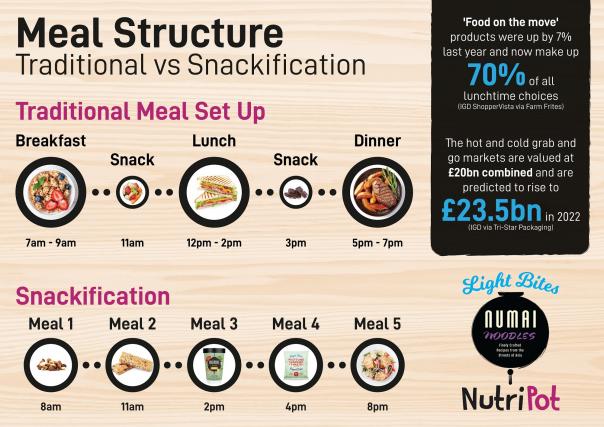
Also called ‘grazing’, eating ‘little and often’, or even just ‘snacking’, people have, in fact, been adopting the habit long before it had a name and simply because it fits in with modern, busy lifestyles.
Robert Rona, director of new markets, products and services at The Triangle Nutrition LTD says “snackification has predominately become more popular due to a shift of lifestyle, with people spending less time in their hoes for the meals of the day.
“The modern consumer spends their mornings at the gym, days in the office and evenings socialising so it’s very difficult to sit down and enjoy three meals per day.
“The reliance on convenience food was the first demand, but since the interest in health and nutrition has increased, convenient food options need to be providing an additional benefit.
“This could be providing a source of an individual food group, such as protein, or the recommended daily allowance of vitamins and minerals.”
Adaption
The main draw to ‘snackification’ is that it can be adapted to suit any lifestyle. Often, it includes smaller versions of regular meals.
“Consumers are swapping sit down meals for ‘snackfast’ options in the morning and meals-on-the-go make lunch and dinner options easier,” added Rona.
“They might eat first thing in the morning and then again at 10am, or eating something en route to a meeting at 11:30am and again at 3pm when it’s finished.
“The flexibility and convenience of the health-conscious snackification movement means that consumers can eat what they want when they want – without worrying about calorie intake or nutritional levels.”
Embracing change
It is ultimately a food movement that retailers should be more aware of and embrace.
“Ultimately, it provides an increased opportunity to upsell to customers. Rather than grabbing one meal, those who prefer to eat little and often will pick up all four or five “meals” in one sale,” explains Rona.
“It also allows retailers to evolve their cross-category selling. We have the standard “meal deal” of a sandwich, crisps and drink, but there’s nothing stopping retailers from incorporating pot-based meals, ready to drink shakes, meal bars and more”.
The difficulty for brands and retailers, which is the same for all food trends, is that the popularity and demand can fluctuate. Snacking has always been a part of consumer lifestyle, it’s quick and convenient, but lifestyles are constantly changing.
Rona says that “It might not happen overnight, it might not happen in a year, but lifestyles and consumer needs are constantly changing, so it can be a risk for a brand or retailer to focus solely on a food movement.”
“However, the trend of snacking is never going to go away, and the popularity of following a healthier lifestyle is constantly growing, so brands and retailers would be missing a trick to not embrace this. The great thing about creating products to fit into snackification is that they can be eaten as a standalone product or as part of this movement.”